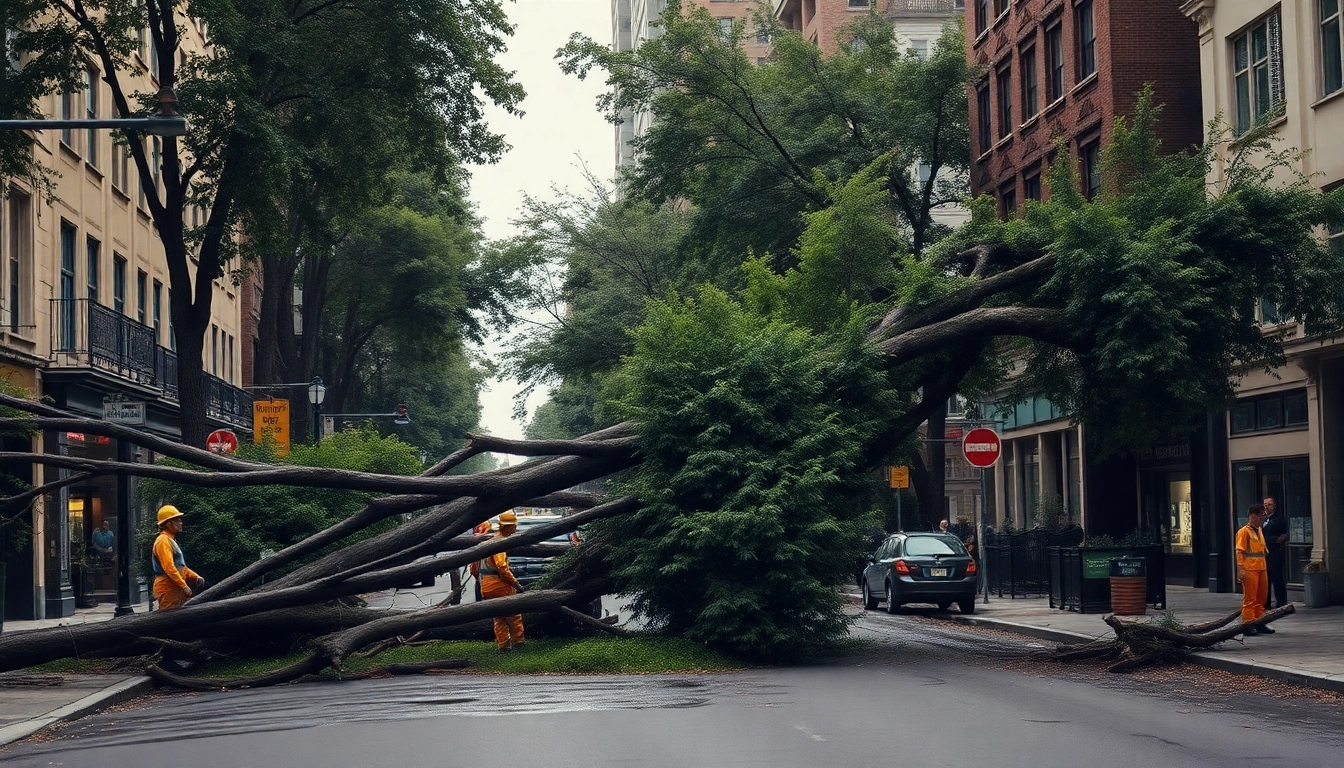Reliable Emergency Tree Service: Your Guide to Quick Recovery and Safety
Understanding Emergency Tree Service
When a storm rolls in or an unexpected natural event occurs, the safety of your property heavily relies on the health and stability of the trees surrounding it. In these moments, knowing that a reliable emergency tree service is available becomes paramount. Emergency tree services specialize in addressing urgent tree issues, ensuring that hazards are mitigated swiftly and effectively. But what exactly constitutes an emergency, and why is a timely response crucial? Let’s explore these questions in detail.
What Constitutes an Emergency?
An emergency tree service situation typically arises when a tree poses an immediate risk to people, property, or infrastructure. Common scenarios include:
- Tree Collapse: A tree or branches have fallen onto a structure, road, or power line.
- Severe Damage: Trees that are severely leaning or are partially uprooted due to strong winds or other environmental factors.
- Injury Risks: Branches that threaten to fall, creating a potential hazard for pedestrians or vehicles.
In these cases, quick action is essential to prevent further damage and ensure safety.
Why Timely Response Matters in Emergency Situations
The importance of a timely response in emergency tree situations cannot be overstated. Delays can lead to exacerbated damage, increased repair costs, and heightened safety risks. For example, a tree that remains partially fallen may cause significant structural damage or result in injury, leading to legal repercussions and financial liability for homeowners. Furthermore, emergencies can escalate; for instance, an unresolved leaning tree may succumb to additional weather events and fall unexpectedly, causing harm or damage to surrounding areas.
Key Services Offered by Emergency Tree Specialists
Emergency tree specialists provide a range of critical services, including:
- Emergency Tree Removal: Prompt and safe removal of hazardous trees or branches to eliminate risk.
- Trimming and Pruning: Reducing weight and risk on compromised branches to prevent further incidents.
- Stump Grinding: Removing tree stumps that pose tripping hazards or obstruct further landscaping efforts.
- Debris Cleanup: Clearing the area of fallen branches and debris to restore safety and accessibility.
These services not only protect property and life but can also help to preserve the remaining healthy trees in the area.
Identifying Tree Hazards in Your Area
Being proactive about tree maintenance is essential for preventing emergencies. Recognizing tree hazards in your area can mitigate the risk of unexpected incidents.
Common Signs of Unsafe Trees
There are several indicators that a tree may be dangerous:
- Cracks and Cavities: Visible cracks in the trunk, or cavities indicating internal decay.
- Dead or Dying Branches: Branches that lack foliage, show signs of rot, or are brittle may fall at any moment.
- Leaning Trees: Trees that lean noticeably, especially if they also have root exposure.
- Fungal Growth: The presence of mushrooms or fungi is often a sign of internal decay.
Assessing Risks After Severe Weather
After intense storms or natural disasters, a thorough assessment of trees is critical. Inspecting for broken branches, uprooted trees, and leaning structures should be an immediate priority. Homeowners should carefully evaluate areas around their property, focusing on trees that are close to structures or under power lines, as these pose significant risks.
When to Call for Emergency Tree Service
In the event of noticing any concerning signs or after severe weather, it is vital to know when to contact an emergency tree service. If a tree appears to be in immediate danger of falling or if it has already fallen and caused disruptions, contacting professionals is essential. Ignoring these cries for help can lead to costly repairs and potential safety hazards.
Best Practices for Tree Safety and Maintenance
Preventative measures and regular maintenance play crucial roles in tree safety. Implementing best practices not only minimizes risks but also enhances the longevity of your trees.
Regular Inspections and Prevention Strategies
Scheduled inspections by certified arborists are critical. These professionals can identify potential issues and recommend the necessary maintenance to keep trees healthy and safe. Homeowners should also regularly monitor their trees themselves, evaluating for signs of illness or distress.
How to Choose the Right Tree Care Professionals
When selecting tree care professionals, ensure they have the requisite credentials. Look for certified arborists who have the experience necessary to identify issues and handle emergencies. Getting multiple quotes and references can help in choosing a reliable service.
Preventative Measures for Less Severe Weather
Before less severe weather events, homeowners can take several proactive steps:
- Pruning: Removing dead or weak branches before storms can prevent further damage.
- Mulching: This helps maintain tree health and moisture during dry spells.
- Watering: Adequate watering during drier months can help trees withstand windy or stormy conditions.
Emergency Tree Response: What to Expect?
Understanding the emergency tree response process can alleviate some of the stress surrounding these situations.
The Process of Emergency Tree Removal
When professionals arrive on the scene, they will first conduct a risk assessment to determine the safest approach for tree removal. They will then utilize specialized equipment to remove the tree or branches, ensuring that surrounding property remains unharmed during the process. Safety gear and protocols are critical in these operations, conducted by trained experts.
Aftercare and Restoration Steps Post-Removal
After a tree has been removed, assessing the area for further risks and restoring the landscape is crucial. This may include:
- Clearing Debris: Removing branches and debris left behind.
- Stump Grinding: Ensuring that tree stumps do not cause hazards in the landscaping.
- Soil Restoration: Filling in any holes left by fallen trees to promote healthy future growth.
Evaluating the Damage: Who Covers the Costs?
The financial aspect of emergency tree service can be confusing. Homeowners should check their property insurance policies, as many cover tree removal costs if the tree poses a threat to the home or has caused damage. Understanding coverage and any deductibles can help manage the financial burdens of tree emergencies.
Finding the Right Emergency Tree Service Provider
Choosing the right emergency tree service provider is vital for ensuring optimal service and safety during critical times.
Questions to Ask When Hiring
When interviewing potential contractors, consider these questions:
- What is your certification and training background?
- Do you have insurance to cover liabilities?
- Can you provide references or examples of past work?
Evaluating Reviews and Testimonials
Reviews and testimonials can provide insights into a company’s reliability and quality of service. Look for consumer feedback on platforms like Google and Yelp to gauge customer satisfaction and service performance.
Importance of Certification and Insurance
Only hire companies with proper certification and insurance. This ensures they are qualified to handle tree emergencies safely and efficiently while you are protected from liability for any accidents that may occur during the process.
In conclusion, understanding the nuances of emergency tree service is essential for safeguarding your property and ensuring safety during potentially hazardous situations. By being proactive and informed, homeowners can prevent emergencies and navigate tree-related crises effectively.














Post Comment